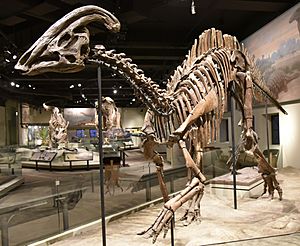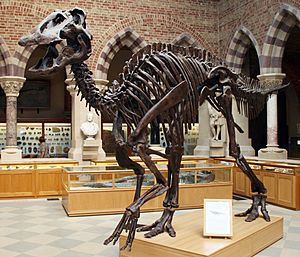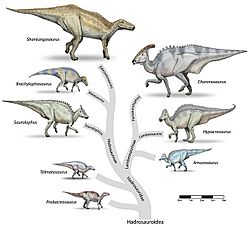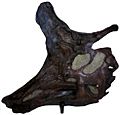Hadrosaur facts for kids
Quick facts for kids Hadrosaurids |
|
|---|---|
 |
|
| Mounted skeleton of Parasaurolophus cyrtocristatus, Field Museum of Natural History | |
 |
|
| Mounted skeleton of Edmontosaurus annectens, Oxford University Museum | |
| Scientific classification |
|
| Kingdom: | Animalia |
| Phylum: | Chordata |
| Clade: | Dinosauria |
| Order: | †Ornithischia |
| Suborder: | †Ornithopoda |
| Clade: | †Hadrosauromorpha |
| Family: | †Hadrosauridae Cope, 1869 |
| Type species | |
| †Hadrosaurus foulkii Leidy, 1858
|
|
| Subgroups | |
|
|
| Synonyms | |
|
|
Hadrosaurs were a group of amazing dinosaurs known for their unique "duck-billed" faces. Their name means "bulky lizards." These plant-eating dinosaurs were very common during the Cretaceous Period.
Hadrosaurs came in many sizes. They could be from 10 to 65 feet (3 to 20 meters) long. They had a tough, toothless beak at the front of their mouths. But behind the beak, they had hundreds of teeth in their cheeks. Some hadrosaurs had up to 960 cheek teeth! This helped them chew tough plants. Their fossils have been found in North America, Europe, and Asia.
Contents
What Made Hadrosaurs Special?
Hadrosaurs had a stiff tail that helped them keep their balance. They had hoof-like nails on their feet. Their skin was often bumpy.
These dinosaurs usually ran on two legs. They held their tail and head straight out. They might have walked on all four legs when they were grazing for food. Hadrosaurs probably lived near water. They may have traveled to higher ground to lay their eggs. Scientists once thought they had webbed hands. But this was just how the fossils looked after being buried for millions of years.
It's interesting that hadrosaurs were so common. Yet, they didn't have obvious ways to defend themselves from large carnivores. Maybe living in herds and being fast runners kept them safe. Their amazing chewing system must have given them an advantage over other plant-eaters.
Discovering the "Dakota" Hadrosaur
In 1999, a very special hadrosaur fossil was found. It was in the Hell Creek Formation in North Dakota. This fossil is called "Dakota." It is so well preserved that scientists could study its muscles. They learned it was more muscular than they thought. This probably helped it run faster than predators like Tyrannosaurus rex.
This "Dakota" fossil is a mummified hadrosaur. It has skin, ligaments, tendons, and maybe even some internal organs. Scientists are studying it with a giant CT scanner. This machine is usually used to check space shuttle engines. Researchers hope this technology will show them more about the dinosaur's insides.
They found a small gap between each vertebra in the spine. This means there might have been soft material there. This would have made the dinosaur more flexible. It also means the animal was a bit longer than skeletons in museums show. Scientists have found skin impressions from many hadrosaurs. These include Edmontosaurus annectens, Corythosaurus casuarius, Brachylophosaurus canadensis, Gryposaurus notabilis, Parasaurolophus walkeri, Lambeosaurus magnicristatus, Lambeosaurus lambei, Saurolophus osborni, and Saurolophus angustirostris.
Two Main Hadrosaur Groups
Scientists have found two main groups, or clades, of hadrosaurs.
- Hadrosaurines (sometimes called Saurolophines) either had solid crests or no crests at all. They were generally larger dinosaurs.
- Lambeosaurines had hollow crests on their heads. They were usually smaller than Hadrosaurines.
Lambeosaurines had narrower beaks than Hadrosaurines. This suggests that Lambeosaurus and its relatives could pick and choose their food more carefully. The broad-beaked hadrosaurines probably ate a wider variety of plants.
Famous Hadrosaur Examples
Here are some well-known hadrosaurs:
Images for kids
-
Skeleton of Maiasaura posed with a nest. This discovery helped change how we saw dinosaurs.
-
Skull of Lambeosaurus, a type of Lambeosaurine.
-
Skull of Saurolophus, a type of Saurolophine.
-
An early drawing by Charles R. Knight showing hadrosaurs in water.
-
Edmontosaurus jaw with teeth, typical for hadrosaurs.
See also
 In Spanish: Hadrosáuridos para niños
In Spanish: Hadrosáuridos para niños












